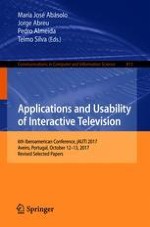2018 | Book
Applications and Usability of Interactive Television
6th Iberoamerican Conference, jAUTI 2017, Aveiro, Portugal, October 12-13, 2017, Revised Selected Papers
Editors: María José Abásolo, Jorge Abreu, Pedro Almeida, Telmo Silva
Publisher: Springer International Publishing
Book Series : Communications in Computer and Information Science
